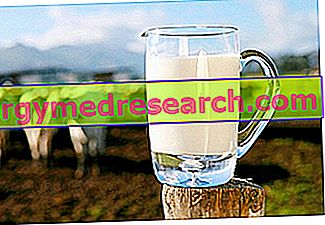What is the Walnut Mallo
The walnut husk is the fleshy part of the fruit produced by the homonymous plant ( Juglans regia L.).

Features
As mentioned, the walnut husk is the pulp within which the entire edible part of the plant (ie the seed that we commonly call "walnut") is immersed.
In other words, the husk can be considered as the pulp of the nut tree fruit.
When the fruit is ripe, the husk is green. This color, with the progress of time, darkens more and more due to the action of the tannins contained in it, coming to assume the typical dark brown color.
Property
The walnut husk contains several active ingredients in it, including tannins, flavonoids and naphthoquinones such as juglone.
The juglone - present both in the husk and in the walnut leaves - has allelopathic properties, as it is capable of conditioning the growth and development of other living beings. In particular, juglone prevents the growth of other botanical species with which it comes into contact.
Juglone is also able to inhibit fungal growth and has antibacterial and astringent properties (the latter, due to the tannin content).
In addition to pigmenting properties, antiseptic, vermifuge and keratinizing properties are also recognized to walnut husks.
Popular medicine
Popular medicine ascribes numerous properties to walnut husks and its derivatives, as well as to the leaves of the plant.
For example, in Chinese folk medicine, husk and walnut leaves are used for the treatment of a wide variety of disorders, such as asthma, constipation, low back pain and even impotence.
uses
The coloring properties of the walnut husk had been known since ancient times. In fact, the Persian peoples used to use walnut husk preparations in order to dye fabrics and carpets.
Currently, walnut husk is traditionally used in the food industry as a dye and flavoring in the production of liqueurs (Nocino). Its health-giving applications are also interesting, since the oil of mallo is traditionally used to protect and tan the skin.
This feature is used by bodybuilders during competitions, to highlight muscular details and take on a more defined appearance.
For the same reason we explain the use of walnut as a dye to give the hair red-brown reflections. In truth, it would be more correct to say that the walnut husk acts more than anything else as a reflex agent on the hair and not as a real dye. However, following repeated applications, the walnut husk is still able to darken light hair.
Moreover, often and willingly, the dried and powdered walnut husk (INCI nomenclature: Juglans regia shell powder or Juglans regia seed coat powder ) is mixed with different types of henna in order to obtain more or less intense reflections on the hair and / or reflections. (for example, to cover white hair).
Action mechanism
The oil obtained from the walnut husk is used in the aesthetic and cosmetic field as a coloring agent to give the skin a tanned appearance and to enrich the hair with brown reflections.
The coloring property of the walnut husk depends on the naphthoquinones it contains, among which the juglone is undoubtedly the most representative. This substance reacts with the keratin present in the hair and in the epidermis, forming a pigmented complexion of brown color.
Although the tan conferred by the oil of mallo is fictitious, in the presence of ultraviolet radiation, the naphthoquinone-keratin complex acts as a selective filter, shielding the skin from UV-B rays on one side and accelerating the rays-induced melanogenesis on the other GRAPES. For this reason, walnut oil is widely used in the formulation of solar products. However, it should be pointed out that despite its protective and partially shielding action, the use of husk oil cannot in any way replace the use of adequate sunscreens.
Warnings and Precautions
Despite the walnut husk and the powder obtained following its drying are readily available products, their use must still be carried out with some precaution.
In fact, walnut husks can be toxic to certain types of animals, such as dogs and horses. Therefore, those who own these animals must carefully handle and preserve the walnut husk and its derivatives, in order to avoid intoxication.
Furthermore, as can be easily deduced, those suffering from allergies to nuts or other types of nuts should in no way use walnut husks, in order to avoid the onset of dangerous allergic reactions.



